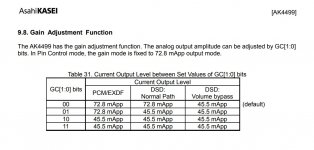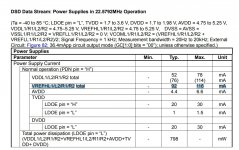Output current varies with settings, which for me is 'DSD volume bypass' mode (please see first attachment).According to AK4499 datasheet VREFHL1/L2/R1/R2 total is 92mA typical and 116 mA max. Same for PCM and DSD.
Regarding Vref current, it is given for 4 channels combined. For one channel the value is one-forth of the total, or 23mA (pleased see second attachment). My Vref power supply is per channel.
Attachments
Last edited:
Sure. Suppose it is 22mA +5mA. If my Vref power supply can easily supply 27mA, and if it sounds good, then what is the problem?If it is 22mA + 5mA signal dependent, that's very different from 22mA constant...
That AKM sound control stuff is old news.That's peculiar. No indication of what the difference may be anywhere?
Here's AK4490 datasheet:
Of course no other explanation given.
Maybe we'll see if they finally learned how to make it into something good/useful. Of course most of the EEs will probably set it to whatever gives the lowest measured distortion or else maybe the lowest THD+N, no?
IMO this sound control stuff is just another attempt to differentiate from competitors (just as the number of digital filters). Soon we will see ESS version of this. ASR will probably have measurements to show the effects.Maybe we'll see if they finally learned how to make it into something good/useful.
AK4499EX is the one without digital processing except for a DEM algorithm, if I remember well, so they either switch something analogue or change the DEM (or both).AK4499EX turns out to have two modes: Measurement Mode and Sound Quality Mode (please see attached). Measurements apparently don't matter so much in SQ Mode.
Based on the graph in the original AK4499 eval board AKM agrees with me in that many people prefer non-linearities and colorisations as that is all the Vref series resistor brings. My guess is that the heavily rising LF distortions try to mimic tube amplifiers which have similar distortion profile due to output transformers. This also agrees with what @altor stated about statistics from users of his ESS based DACs: quite many liked THD compensations tuned to higher harmonics ("tube simulation mode").
I wonder what designers of low-THD amplifiers (such as PMA) think of such gimmicks. IMO DAC should not try to be an effects box. If I want to listen to tube amplifier sound I listen to my tube amplifier.
I wonder what designers of low-THD amplifiers (such as PMA) think of such gimmicks. IMO DAC should not try to be an effects box. If I want to listen to tube amplifier sound I listen to my tube amplifier.
Maybe. But still much higher than many amplifiers. And why have frequency dependent THD on a dac?
Actually since that is a THD+N graph it could also be noise that is increasing at low end.
BTW since Markw4 claimed to have heard a difference the rising LF distortion/noise is clearly not negligibly small and even more negligible to some 😉
Actually since that is a THD+N graph it could also be noise that is increasing at low end.
BTW since Markw4 claimed to have heard a difference the rising LF distortion/noise is clearly not negligibly small and even more negligible to some 😉
Last edited:
As I said before, the distortion is an unwanted byproduct. The purpose of the filter is not to add HD. It only looks that way if measured using a time-averaged, steady-state spectrum analyzer. Don't know why that should be so hard to get across.
I'll give you a hint about what the filter is for, its an effects box more or less in the same way ideal stereo reproduction with two speakers is an effects box. Please consider the following:
https://www.linkwitzlab.com/The_Magic/The Magic in-Edit-SL.pdf
https://www.linkwitzlab.com/AES-Chile'09/Chile-stereo challenge-final.pdf
https://www.linkwitzlab.com/TMT-Leipzig'10/TMT-Hearing spatial detail.pdf
Another hint, look at the way Vrefl and Vrefh are specified in the original AK4499 datasheet. Something is different about the specification of one of them for AK4499EX.
https://www.linkwitzlab.com/The_Magic/The Magic in-Edit-SL.pdf
https://www.linkwitzlab.com/AES-Chile'09/Chile-stereo challenge-final.pdf
https://www.linkwitzlab.com/TMT-Leipzig'10/TMT-Hearing spatial detail.pdf
Another hint, look at the way Vrefl and Vrefh are specified in the original AK4499 datasheet. Something is different about the specification of one of them for AK4499EX.
As I said before since the graph shows THD+N the byproduct could be noise as well. As this is Vref it is quite likely that added series resistance increases noise. The measurement shows increase of either noise or HD which is there regardless if you like it or not.As I said before, the distortion is an unwanted byproduct. The purpose of the filter is not to add HD. It only looks that way if measured using a time-averaged, steady-state spectrum analyzer. Don't know why that should be so hard to get across.
I'll give you a hint. If you want to convince anyone of your theory about the filter try coming up with a sensible explanation why the filter would change the sound stage.I'll give you a hint about what the filter is for
The graph was left out of the first version of the eval board manual. Talking to AKM's field engineer in the Bay Area, he sent me private copy first. They apparently considered it sensitive information, but knew someone would find it with a spectrum analyzer.
Regarding an explanation of the circuit operation, the first thing to do is listen to it. Then ask how and why is there the resulting effect. Starting with a spectrum analyzer hides the time-variant behavior. It disappears into WYSIATI.
Anyway, the circuit includes a total of 20R in series with the cap. But its not one 20R resistor. Its two 10R resistors. Depending on the current through the resistors vrefl and or vrefh are modulated. In addition the cap adds a another factor, i=C dv/dt. Why is the current though the 10R resistors changing? Because current is flowing in or out of the I/V opamp depending on its output voltage. In effect, Vref is modulated according to signal level and rate of change of the audio signal. Mostly what it does is add dynamic linear distortion including phase shifting. The HD is an unwanted byproduct.
It might be mentioned that looking at typical tube power amp voltage regulation, it is rather soft. Sag is an effect well known by guitarists. Also, John Curl amplifiers use rather soft voltage regulation. Why? Is it to add HD?
Regarding an explanation of the circuit operation, the first thing to do is listen to it. Then ask how and why is there the resulting effect. Starting with a spectrum analyzer hides the time-variant behavior. It disappears into WYSIATI.
Anyway, the circuit includes a total of 20R in series with the cap. But its not one 20R resistor. Its two 10R resistors. Depending on the current through the resistors vrefl and or vrefh are modulated. In addition the cap adds a another factor, i=C dv/dt. Why is the current though the 10R resistors changing? Because current is flowing in or out of the I/V opamp depending on its output voltage. In effect, Vref is modulated according to signal level and rate of change of the audio signal. Mostly what it does is add dynamic linear distortion including phase shifting. The HD is an unwanted byproduct.
It might be mentioned that looking at typical tube power amp voltage regulation, it is rather soft. Sag is an effect well known by guitarists. Also, John Curl amplifiers use rather soft voltage regulation. Why? Is it to add HD?
Last edited:
Out of curiosity I tried the 3 sound control settings of AK4490. Default setting (0) has clearly lowest THD. Other settings add 5 to 15 dB 2HD-5HD at 30Hz.
Whether or not HD is unwanted byproduct it is still there. Unless you can eliminate it there is no way to be sure what is causing the claimed audible effect. Based on what I just found out about AK4490 I would guess HD has more impact than you think.Mostly what it does is add dynamic linear distortion including phase shifting. The HD is an unwanted byproduct.
I can hear the HD especially on the electrostatic speakers. Have to say I don't like it, but it can kind of be ignored if one wants to enjoy the spatial widening and deepening while at the same time the speakers tend to disappear. IMHO the perceptual effect is similar to what Linkwitz was trying to accomplish.
Regarding the role of phase, we all know reversing the phase of one speaker has widening effect, but the center suffers LF loss and the sound is phasey as one walks between the speakers. The AKM circuit is much more convincing, presumably because of its dynamic behavior. IMHO its better than a shuffler.
Regarding the role of phase, we all know reversing the phase of one speaker has widening effect, but the center suffers LF loss and the sound is phasey as one walks between the speakers. The AKM circuit is much more convincing, presumably because of its dynamic behavior. IMHO its better than a shuffler.
Last edited:
- Home
- General Interest
- Everything Else
- How we perceive non-linear distortions

